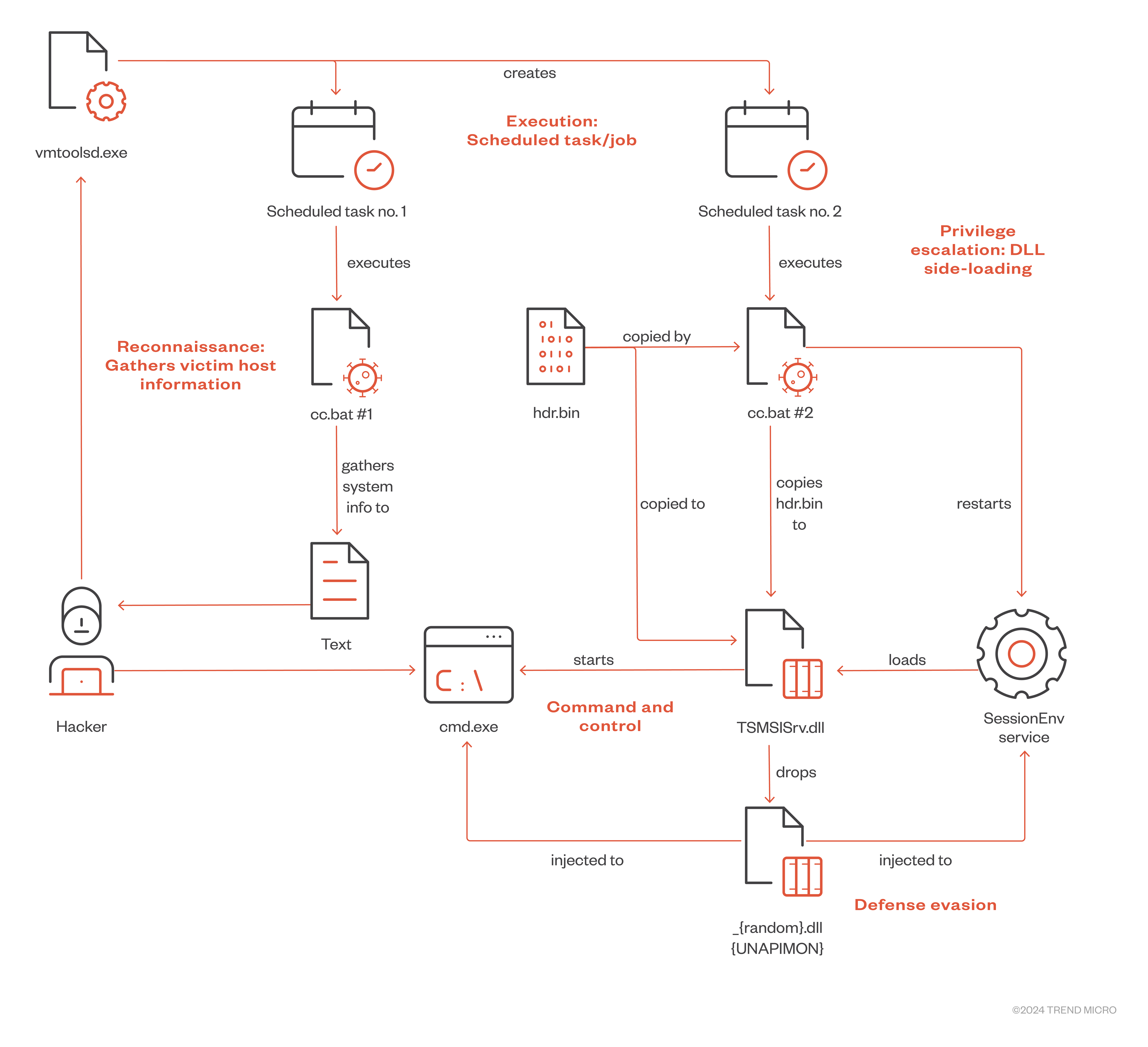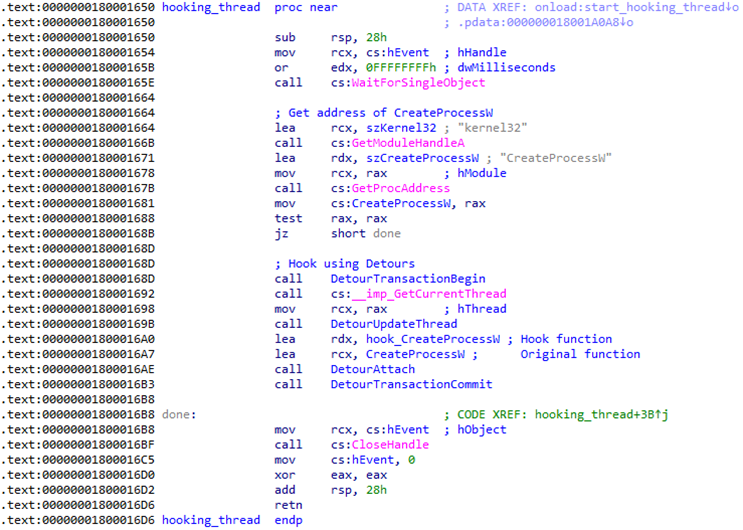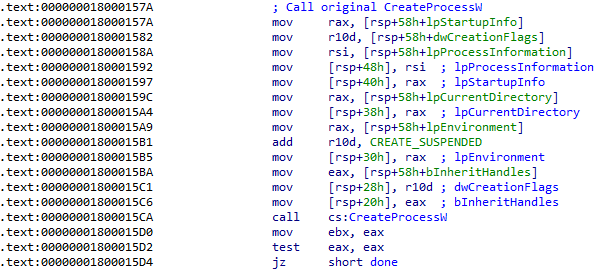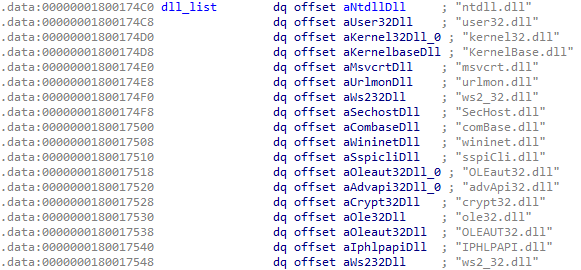APT & Targeted Attacks
Earth Freybug Uses UNAPIMON for Unhooking Critical APIs
This article provides an in-depth look into two techniques used by Earth Freybug actors: dynamic-link library (DLL) hijacking and application programming interface (API) unhooking to prevent child processes from being monitored via a new malware we’ve discovered and dubbed UNAPIMON.
In the past month, we investigated a cyberespionage attack that we have attributed to Earth Freybug (also known as a subset of APT41). Earth Freybug is a cyberthreat group that has been active since at least 2012 that focuses on espionage and financially motivated activities. It has been observed to target organizations from various sectors across different countries. Earth Freybug actors use a diverse range of tools and techniques, including LOLBins and custom malware. This article provides an in-depth look into two techniques used by Earth Freybug actors: dynamic-link library (DLL) hijacking and application programming interface (API) unhooking to prevent child processes from being monitored via a new malware we’ve discovered and dubbed UNAPIMON.
Background of the attack flow
The tactics, techniques, and procedures (TTPs) used in this campaign are similar to the ones from a campaign described in an article published by Cybereason. In this incident, we observed a vmtoolsd.exe process that creates a remote scheduled task using schtasks.exe. Once executed, this launches a pre-deployed cc.bat in the remote machine.

vmtoolsd.exe is a component of VMware Tools called VMware user process, which is installed and run inside a guest virtual machine to facilitate communication with the host machine. Meanwhile, schtasks.exe is a component of Windows called Task Scheduler Configuration Tool, which is used to manage tasks in a local or remote machine. Based on the behavior we observed from our telemetry, a code of unknown origin was injected in vmtoolsd.exe that started schtasks.exe. It’s important to note that both vmtoolsd.exe and schtasks.exe are legitimate files. Although the origin of the malicious code in vmtoolsd.exe in this incident is unknown, there have been documented infections wherein vulnerabilities in legitimate applications were exploited via vulnerable external-facing servers.

First cc.bat for reconnaissance
Once the scheduled task is triggered, a previously deployed batch file, %System%\cc.bat, is executed in the remote machine. Based on our telemetry, this batch file launches commands to gather system information. Among the commands executed are:
- powershell.exe -command "Get-NetAdapter |select InterfaceGuid"
- arp -a
- ipconfig /all
- fsutil fsinfo drives
- query user
- net localgroup administrators
- systeminfo
- whoami
- netstat -anb -p tcp
- net start
- tasklist /v
- net session
- net share
- net accounts
- net use
- net user
- net view
- net view /domain
- net time \\127.0.0.1
- net localgroup administrators /domain
- wmic nic get "guid"
The system information gathered via these commands is gathered in a text file called %System%\res.txt.
Once this is done, another scheduled task is set up to execute %Windows%\Installer\cc.bat in the target machine, which launches a backdoor.
Second cc.bat hijacking for DLL side-loading
The second cc.bat is notable for leveraging a service that loads a nonexistent library to side-load a malicious DLL. In this case, the service is SessionEnv. A detailed technical description of how this technique works can be found here. In this technique, this second cc.bat first copies a previously dropped %Windows%\Installer\hdr.bin to %System%\TSMSISrv.DLL. It then stops the SessionEnv service, waits for a few seconds, then restarts the service. This will make the service load and execute the file %System%\TSMSISrv.DLL.
Two actions of interest done by TSMSISrv.DLL are dropping and loading a file named Windows%\_{5 to 9 random alphabetic characters}.dll and starting a cmd.exe process in which the same dropped DLL is also injected. Based on telemetry data, we noticed that this instance of cmd.exe is used to execute commands coming from another machine, thus turning it into a backdoor. We dubbed the dropped DLL loaded in both the service and cmd.exe as UNAPIMON.
Introducing UNAPIMON for defense evasion
An interesting thing that we observed in this attack is the use of a peculiar malware that we named UNAPIMON. In its essence, UNAPIMON employs defense evasion techniques to prevent child processes from being monitored, which we detail in the succeeding sections.
Malware analysis
UNAPIMON itself is straightforward: It is a DLL malware written in C++ and is neither packed nor obfuscated; it is not encrypted save for a single string.
At the DllMain function, it first checks whether it is being loaded or unloaded. When the DLL is being loaded, it creates an event object for synchronization, and starts the hooking thread.
As shown in Figure 3, the hooking thread first obtains the address of the function CreateProcessW from kernel32.dll, which it saves for later use. CreateProcessW is one of the Windows API functions that can be used to create a process. It then installs a hook on it using Microsoft Detours, an open-source software package developed by Microsoft for monitoring and instrumenting API calls on Windows.

This mechanism redirects any calls made to CreateProcessW from a process where this DLL is loaded to the hook.
The hook function calls the original CreateProcessW using the previously saved address to create the actual process but with the value CREATE_SUSPENDED (4) in the creation flags parameter. This effectively creates the process, but whose main thread is suspended.

It then walks through a list of hardcoded DLL names as shown in Figure 5.

For each DLL in the list that is loaded in the child process, it creates a copy of the DLL file to %User Temp%\_{5 to 9 random alphabetic characters}.dll (hereafter to be referred to as the local copy), which it then loads using the API function LoadLibraryEx with the parameter DONT_RESOLVE_DLL_REFERENCES (1). It does this to prevent a loading error as described in this article.

After the local copy of the DLL has been loaded, it then proceeds to create a local memory copy of the loaded DLL image with the same name in the child process. To ensure that the two DLLs are the same, it compares both the values of the checksum field in the headers and the values of the number of name pointers in the export table.
Once verified to be identical, it walks through all exported addresses in the export table. For each exported address, it checks to ensure that the address points to a code in an executable memory page, and that the starting code has been modified. Specifically, it checks if the memory page protection has the values PAGE_EXECUTE (0x10), PAGE_EXECUTE_READ (0x20), or PAGE_EXECUTE_READWRITE (0x40). Modifications are detected if the first byte in the exported address is either 0xE8 (CALL), 0xE9 (JMP), or if its first two bytes are not equal to the corresponding first two bytes in the loaded local copy. Additionally, it also verifies that the name of the exported address is not RtlNtdllName, which contains data instead of executable code.

If an exported address passes these tests, it is added to a list for unpatching.
Once all the DLL names in the list have been processed, it walks through each of the addresses in the unpatching list. For each address, it copies 8 bytes from the loaded local copy (the original) to the remote address, which has been previously modified. This effectively removes any code patches applied to an exported address.

Finally, it unloads and deletes the randomly named local copy of the DLL and resumes the main thread. When the malware is unloaded, it removes the hook from CreateProcessW.
Impact
Looking at the behavior of UNAPIMON and how it was used in the attack, we can infer that its primary purpose is to unhook critical API functions in any child process. For environments that implement API monitoring through hooking such as sandboxing systems, UNAPIMON will prevent child processes from being monitored. Thus, this malware can allow any malicious child process to be executed with its behavior undetected.
A unique and notable feature of this malware is its simplicity and originality. Its use of existing technologies, such as Microsoft Detours, shows that any simple and off-the-shelf library can be used maliciously if used creatively. This also displayed the coding prowess and creativity of the malware writer. In typical scenarios, it is the malware that does the hooking. However, it is the opposite in this case.
Security recommendations
In this specific Earth Freybug attack, the threat actor used administrator accounts, which means that the threat actors knew the admin credentials, rendering group policies useless. The only way to prevent this from happening in an environment is good housekeeping, which involves frequent password rotation, limiting access to admin accounts to actual admins, and activity logging.
In this incident, data exfiltration was done using a third-party collaborative software platform over which we do not have control. Even if the write permissions were revoked for affected folders that could be accessed through the collaborative software, the threat actor could just simply override it, since the threat actor is the admin from the system’s point of view.
Users should restrict admin privileges and follow the principle of least privilege. The fewer people with admin privileges, the fewer loopholes in the system malicious actors can take advantage of.
Conclusion
Earth Freybug has been around for quite some time, and their methods have been seen to evolve through time. This was evident from what we observed from this attack: We concluded that they are still actively finding ways to improve their techniques to successfully achieve their goals.
This attack also demonstrates that even simple techniques can be used effectively when applied correctly. Implementing these techniques to an existing attack pattern makes the attack more difficult to discover. Security researchers and SOCs must keep a watchful eye not only on malicious actors’ advanced techniques, but also the simple ones that are easily overlooked.
Indicator of compromise
| Hash | Detection name |
|---|---|
| 62ad0407a9cce34afb428dee972292d2aa23c78cbc1a44627cb2e8b945195bc2 | Trojan.Win64.UNAPIMON.ZTLB |

